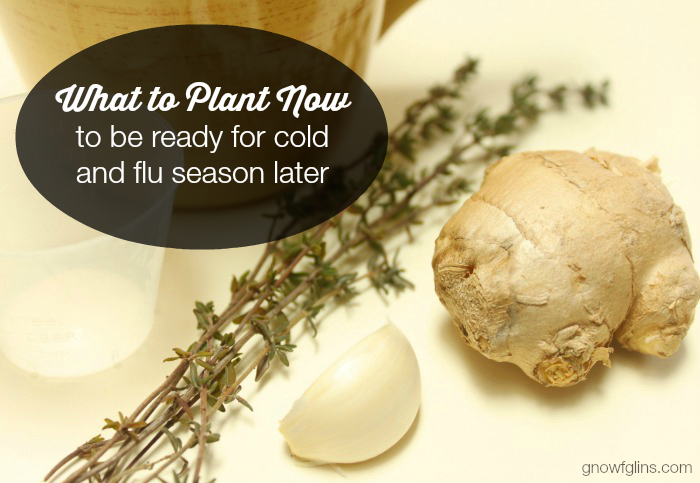
Spring is here! With the cold of winter finally behind us, the last thing you are thinking of is the cold and flu season. However, a little thought and planning now can make for a garden full of natural healers when the coughs and sniffles return.
The Basics
These five plants are well-known, easy-to-grow, and a must-have in any medicinal garden.
Garlic. By far one of nature’s best healers, garlic is a potent cold and flu fighter. It has antiseptic, antibacterial, and antimicrobial properties, and stimulates the immune system. I take it whole, add it to cold-kicker concoctions, use it to treat earaches, and often cook with it. Although best planted during the fall, in cold climates like mine, there is no harm in planting it during the early spring for this year’s harvest, and planting again in the fall for next year’s.
Horseradish. You probably know how strong fresh horseradish can be. My grandmother used to say, “That will clear your sinuses!” and she was right. If you can stand the heat, fresh horseradish clears clogged nasal passages right up! It is an antiseptic and full of vitamins and minerals. Mix it with honey and apple cider vinegar to calm the flavor. And please, learn from my mistakes: plant it in a contained section of your garden, or a large pot. This plant spreads!
Ginger. A well-known anti-nauseant and one of my personal favorites, ginger is easy to grow in a large pot inside since it suffers in cold climates. It is beneficial for clearing up respiratory congestion and sore throats.
Sage. If you plan to use it in your cooking, sage is a popular herb in many gardens. However, it is useful for fighting off illness as well. It is antiseptic, anti-inflammatory, and fights against laryngitis, tonsillitis, and sore throats.
Thyme. This is another culinary herb with a rich medicinal profile. Thyme, my go-to cough medicine, has disinfectant and antifungal properties. It can be used as a rinse to soothe sore throats and fights against colds.
For the Adventurous Gardener
If you’re ready to step beyond the fundamentals, these three additional herbs are perfect for you.
Elder. I have noticed a lot of written material lately extolling the benefits of elderberries, and for good reason! Since they are immune-boosting and anti-viral, they fight off both colds and the flu (like this elderberry tincture). The plant itself can grow as tall as 30 feet, so it will need space in your garden. I haven’t yet grown it, but I hope to soon!
Echinacea. Although widely-known and easy-to-grow, capturing the medicinal properties of echinacea is difficult. Its immune-boosting prowess is known even outside of herbal circles. Use the whole plant, gathered over the course of one whole season, to make the most effective medicines.
Goldenseal. This is one of my favorites for treating sinus congestion, infections, and colds in general. I stopped using it when I discovered it was becoming endangered, so, although a little tricky to grow, I can’t wait to try it in my own garden.
These plants are more than just cold and flu fighters. There is enough plant power here to fight off a variety of maladies and help you maintain health all year long!
Do you grow medicinal herbs in your garden? What are your favourite cold and flu fighters?
...without giving up the foods you love or spending all day in the kitchen!

2 free books:
Eat God's Way
Ditch the Standard American Diet, get healthier & happier, and save money on groceries...
We only recommend products and services we wholeheartedly endorse. This post may contain special links through which we earn a small commission if you make a purchase (though your price is the same).


Do you have any idea how long fresh grated horseradish mixed with raw honey will stay good?
Hi Jessica,
I make an infusion of horseradish in apple cider vinegar, and then mix it with honey and it keeps for months in the fridge, and I have read that you can mix grated horseradish with apple cider vinegar and store it in the fridge indefinitely, but I’m not sure about mixing it with honey. Maybe someone else will know? Sorry I can’t be of more help!
Great post! I’ve got my garlic growing! I’ve never tried horseradish though because, like you mentioned I’ve heard that it can be invasive. I’d still like to give it a try.
Hi Jenny, I learned the hard way not to plant horseradish directly in the garden as it is just about impossible to control. (I hope the people who bought my last house like horseradish!) 🙂 I discovered that I could get enough to grow in a medium-sized pot to at least make a batch of the cold-kicker remedy. This year I am going to try growing it in a tub and see if I can’t get a better harvest. I’d love to have garlic planted already but my gardens are still covered in a foot of snow! Hopefully soon! 🙂
Which ginger is used for medicinal and consumption pur? I have seen many variations here. I live in south Louisiana. Thanks for your great page!
This is the type I am familiar with Nanette: http://www.richters.com/Web_store/web_store.cgi?product=X2862&show=all&prodclass=&cart_id=4934582.27266 It is the one I use for both culinary and medicinal uses.
What can you tell us about wild ginger? We live in southern PA, and have quite a bit growing wild in our back woodland. It comes back year after year, but I don’t know if it’s edible. We have a very large tea patch and would love to being using ginger in some of our tea brews. Thanks for the great post! 🙂
Hi Lisa,
From what I have read, wild ginger is also an edible herb and often used as a ginger substitute. Traditionally it was also used to treat indigestion, coughs, colds, fever, sore throat, flatulence, and nervous conditions. There are also some reports that it can be toxic in high doses, so, like in everything, moderation is best. 🙂
Turmeric grows in a pot like ginger, but has leaves that make the plants look more like stemless cannas. Very tropical-looking, but hardy into zone 7. The fresh root stains like nobody’s business, of course.
I have recently been reading about the benefits of turmeric. Thanks for the tip!